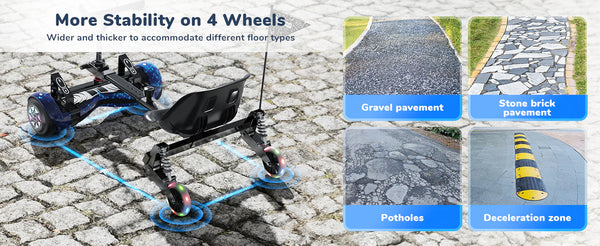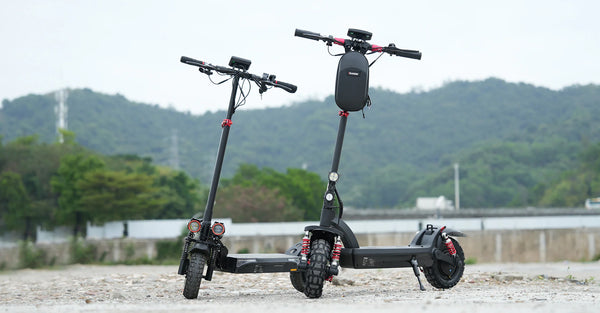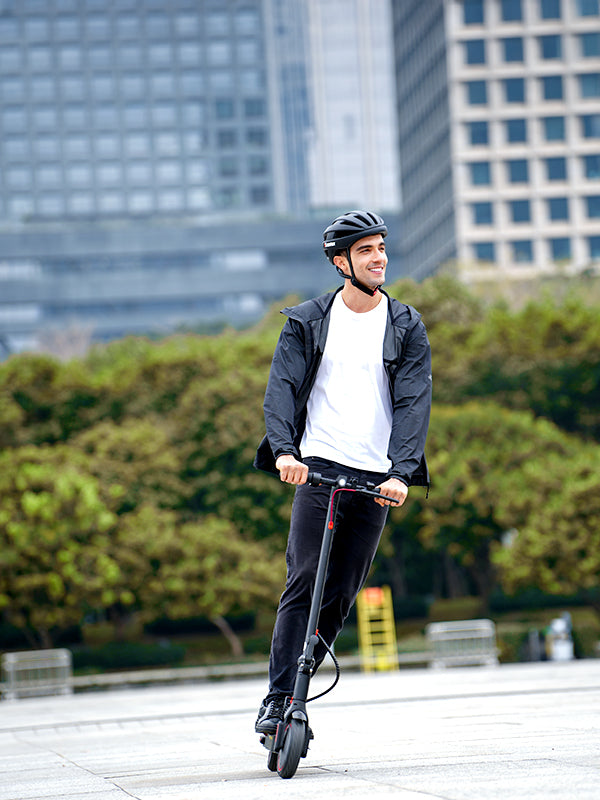
Can I Fix the Electric Scooter Motor by Myself?
Electric scooters have revolutionized personal transportation with their convenience, eco-friendliness, and affordability. However, like any mechanical device, they are prone to wear and tear, especially in their motors, which are the driving force behind their functionality.
When faced with a malfunctioning electric scooter motor, many people wonder, "Can I fix the electric scooter motor by myself?" We’ll explore whether it's feasible to repair an electric scooter motor at home, the tools you need, common motor issues, and when it’s best to call in a professional.
How Does an Electric Scooter Motor Work?
Before attempting to fix your scooter, it’s important to understand how an electric scooter motor works. Most electric scooters are powered by brushless DC motors (BLDC), which convert electrical energy into mechanical energy. This enables the scooter to move. The motor is composed of several components, including the rotor (which rotates), the stator (stationary part), magnets, and coils.

Image: Rear Motor Wheel for Electric Scooter iX4
The motor operates by receiving electrical power from the scooter’s battery, which is then regulated by a controller. When the throttle is engaged, electrical current flows through the motor’s coils, creating a magnetic field that causes the rotor to spin. Over time, various factors can impair this process, from debris and dust entering the motor to worn-out wiring or overheating due to prolonged use. These issues can affect the overall performance of the electric scooter motor.
Understanding the basics of motor operation is key to assessing whether a DIY repair is possible. While some problems are relatively simple to fix, others may require professional tools or expertise.
Common Issues with Electric Scooter Motors
Before diving into whether you can fix the motor yourself, it’s crucial to identify the most common issues affecting electric scooter motors. Some problems are minor and can be easily resolved with the right tools, while others are more complex and might require professional assistance.
Overheating
One of the most frequent issues is overheating. Prolonged use of the scooter, especially on challenging terrain like steep hills or rough roads, can cause the motor to overheat. Overheating can damage the internal components, leading to reduced performance or complete motor failure.
In most cases, allowing the motor to cool down and avoiding extended high-stress rides can prevent further damage. However, if the motor has overheated repeatedly, more significant repairs may be necessary.
Dirt and Debris Buildup
Another common problem is dirt and debris buildup. The motor, located near the scooter’s wheels, is often exposed to the elements, making it susceptible to accumulating dust, dirt, and small debris. Over time, this can cause blockages that hinder the motor’s operation. Cleaning the motor regularly can prevent such issues, but if debris has already infiltrated the internal components, disassembling the motor to remove the buildup may be necessary.
Loose Wiring
Loose wiring is another issue that plagues electric scooter motors. The vibrations caused by riding over uneven surfaces can loosen the motor's internal wiring or connections, leading to intermittent power loss or complete motor failure. Inspecting the wiring and ensuring everything is securely connected is a common DIY solution for this type of problem.
Wear and Tear
Finally, wear and tear on the motor’s components is inevitable with regular use. Bearings, in particular, are susceptible to wearing down over time, causing friction that reduces the motor’s efficiency. Replacing bearings is possible, but it requires specialized tools and a certain level of technical knowledge.
When Should You Attempt to Fix the Motor Yourself?
Not every issue with an electric scooter motor requires professional attention. Some problems are minor enough that they can be addressed at home with basic tools and a little know-how. Here’s a breakdown of when you might consider fixing the motor yourself:
Cleaning and Maintenance
Cleaning is one of the simplest and most effective ways to maintain the performance of your electric scooter motor. Dust, dirt, and small debris can cause blockages that reduce motor efficiency. Regularly cleaning the motor can prevent these issues and ensure smooth operation.
To clean the motor, start by disconnecting the battery and removing the motor cover. Use a soft brush or compressed air to remove dust and debris from the motor’s internal components. Make sure to be gentle to avoid damaging any of the delicate parts. Once the motor is clean, reassemble it and reconnect the battery.
Checking and Securing Wiring
Loose wiring is a common issue that can easily be fixed at home. Begin by turning off the scooter and disconnecting the battery. Remove the motor cover to access the internal wiring. Check for any loose or disconnected wires, and use electrical tape or wire connectors to secure them in place. Be sure to inspect the wiring for any signs of wear or damage, and replace any frayed or worn wires as needed.
If the issue persists after securing the wiring, it may be related to the controller or battery, which could require further investigation or professional repair.
Replacing Minor Components
Some scooter motor components, such as bearings or fuses, can be replaced without too much difficulty if you have the right tools. Bearings, for instance, wear out over time and need to be replaced to maintain the motor’s efficiency. Replacing bearings typically requires a bearing puller and a replacement bearing set that matches the specifications of your motor.
However, replacing bearings or other small components can be challenging for someone without experience in motor repair. If you’re not comfortable handling this kind of work, it may be safer to leave it to a professional.
When to Call a Professional?
While there are several issues you can fix yourself, there are also situations where professional assistance is necessary. Attempting to fix complex problems without the right expertise can lead to further damage or even void the scooter’s warranty. Here are some cases where it’s best to call in a professional:
Motor Burnout
One of the most serious issues an electric scooter motor can face is burnout. Burnout occurs when the motor overheats to the point where the internal components are irreparably damaged. This can happen if the motor is used continuously at high speeds or under heavy loads. If the motor has burnt out, it will need to be replaced or rewound by a professional. Attempting to fix a burnt-out motor without the proper tools and experience can make the situation worse.
Electrical Failures
If your motor isn’t receiving power or is only working intermittently, it could be due to an electrical failure. Diagnosing and repairing electrical issues requires specialized tools like a multimeter, as well as an understanding of how the scooter’s electrical system works. Electrical repairs should always be handled by a professional to avoid the risk of electric shock or further damage to the scooter.
Major Component Replacements
While minor components like bearings or fuses can be replaced at home, more significant components like the motor itself or the controller should be replaced by a professional. These parts are expensive and difficult to install without the right knowledge and tools. If you need to replace the motor or controller, it’s worth investing in professional help to ensure the job is done correctly.
Warranty Concerns
Many electric scooters come with warranties that cover repairs or replacements for a set period. However, attempting DIY repairs can void the warranty, leaving you responsible for the full cost of any future repairs. If your scooter is still under warranty, it’s best to contact the manufacturer or an authorized repair center to handle any motor-related issues.
Tools and Equipment You’ll Need for DIY Repairs
If you decide to attempt fixing your electric scooter motor yourself, it’s important to have the right tools and equipment on hand. Here are some basic tools you’ll need for most DIY motor repairs:
- Screwdrivers (Phillips and flathead)
- Allen wrenches
- Multimeter (for testing electrical connections)
- Electrical tape
- Wire cutters and strippers
- Soldering iron (for fixing or replacing wiring)
- Compressed air (for cleaning debris)
For more advanced repairs, such as replacing bearings or fuses, you may also need a bearing puller, replacement bearings, and other specialized tools.
It’s crucial to follow safety precautions when working on your scooter. Always disconnect the battery before starting any repairs to avoid electric shock, and wear protective gloves to prevent injury from sharp components or tools.
Cost and Time Considerations
Fixing an electric scooter motor by yourself can save you money, but it’s important to weigh the potential savings against the time and effort required. For minor repairs like cleaning or securing wiring, the cost is minimal—primarily the price of basic tools like screwdrivers, electrical tape, and a multimeter, which can range from $20 to $50 if you don’t already own them.
However, for more complex repairs, such as replacing bearings or diagnosing electrical failures, you may need to invest in specialized tools or replacement parts. Bearings, for example, can cost between $10 and $30, while a new motor or controller can run upwards of $100. If you don’t have experience with these types of repairs, the time and effort required to learn and complete the job may outweigh the cost savings.
Hiring a professional to repair your motor can be more expensive upfront, but it ensures that the repair is done correctly and safely. Professional repair costs vary depending on the complexity of the issue, but you can expect to pay anywhere from $50 to $150 for most motor repairs. If your scooter is still under warranty, the repair may even be covered at no additional cost.
Conclusion
Fixing an electric scooter motor by yourself is possible for certain issues, such as cleaning debris, securing loose wiring, or replacing minor components like bearings. However, more complex problems, such as motor burnout or electrical failures, should be handled by a professional to avoid further damage and ensure the scooter operates safely.
Before attempting any DIY repairs, it’s important to assess your skill level, gather the necessary tools, and consider the potential costs and risks. If you’re unsure about any aspect of the repair, it’s always best to consult a professional to ensure the job is done correctly. By following these guidelines, you’ll be able to keep your electric scooter running smoothly and avoid costly breakdowns in the future.
Product Category
Recent Posts

Up to 50% Off! Our Black Friday 2024 Event Is HERE!

Best Hoverboard with Seat: K3 Hoverboard Go-Kart Guide!

Go-Kart: The Complete Guide to Hoverboard with Seat

Electric Scooter Wheels: Solid Tires vs Pneumatic Tires





















































Still, need help? Contact Us: support@ihoverboard.com
What's the option? Check out the option now!
Leave us a message